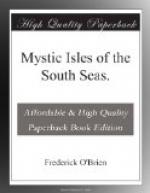“Tooti was in love with Oberea,” said the chief. “She was hinaaro puai.”
The expression is difficult to translate, but Sappho and Cleopatra expressed it in their lives; perhaps ardent in love would be a mild synonym.
At last, after hard struggles, we reached Point Mahaiatea, the “point” of Cook, on the bay of Popoti, which swept from it to the beginning of the valley of Taharuu. The reef was very close to the shore, and the sea had encroached upon the land, covering a considerable area of the site of the marae. The waves had torn away the coral blocks, and they lay in confusion in the water. The beach, too, was paved with coral fragments, the debris of the temple. Though devastated thus by time, by the waves, and by the hands of house-, bridge-, and road-builders, by lime-makers, and iconoclastic vandals, the marae yet had majesty and an air of mystery. It was not nearly of the original height, hardly a third of it, and was covered with twisted and gnarled toa, or ironwood, trees like banians, the etoa of Cook, and by very tall and broad pandanus, by masses of lantana and other flowering growths. Tetuanui, Brooke, and I stumbled through these, and walked about the uneven top, once the floor of the temple.
“Every man in Tahiti brought one stone, and the marae was builded,” said Tetuanui. “We were many then.”
He had not been there in fifty years.
We crawled down the other side, a broken incline, and to the beach. Land-crabs scrambled for their holes, the sole inhabitants of the spot once given to chants and prayers, burials, and the sacrifice of humans to the never-satisfied gods. There was an acrid humor in the name of the bay on which we looked, Popoti meaning cockroach. That malodorous insect would be on this shore when the last Tahitian was dead. It existed hundreds of millions of years before man, and had not changed. It was one of the oldest forms of present life, better fitted to survive than the breed of Plato, Shakespere, or Washington. Its insect kind was the most dangerous enemy man had: the only form of life he had not conquered, and would be crooning cradle-songs when humanity, perhaps through its agency, or perhaps through the sun growing cold, had passed from the earth. Not impossibly, insects would render extinct all other beings, and then the cockroach could proclaim that creation had its apotheosis in it.
The marae was the cathedral of the Tahitians. About it focused all the ceremonies of the worship of divinity, of consecration of priests and warriors to their gods and their chiefs. The oldest marae was that of Opoa, on the island of Raiatea, the source of the religion of these groups. It was built by Hiro, the first king of Raiatea, who, deified after death, became the god of thieves. The Papara marae was made of coral, but the quarried mountain rock was laid at the foundation, and these ponderous, uneven stones being patched with coral, in time the blocks had become tightly cemented together. A lime-kiln was along the land side of this marae of Oberea, and for years had furnished the cement, plaster, and whitewash of the district.




